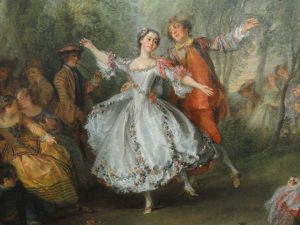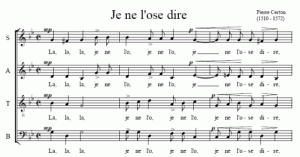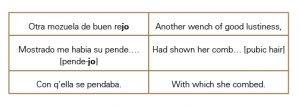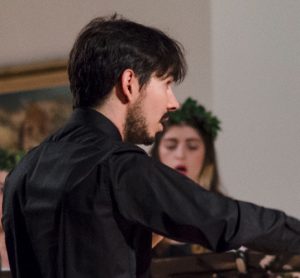When exploring music from the Renaissance period, there is clearly a close connection between music and lyrics. Madrigals, for example, express the text through sounds; words are musically depicted not only in the individual melodies, but also through the atmosphere created by all of the elements together.
This close relationship is useful to help understanding in two ways: the lyrics direct the meaning and the intention of the music, and likewise often the music gives some clues as to what is being said. However, it could be stated that the message is rarely fully understood, which is not only because of the way in which time has modified language, but also because, frequently, composers prefer to hide some of their ideas, as they should probably not be explicitly expressed.
This text will take you on a short journey through some pieces of Renaissance music, illustrating different mechanisms that composers used to deal particularly with those messages that should not be voiced. The text will start by referring to some English songs and then will move to French and Spanish repertoires. There are certainly a lot of good, interesting examples in other languages, but we specifically chose these three languages as we have worked closely with them in “El Grilo”, the choir of which I am the Musical Director. Before continuing, I would like to say that this is not intended to be a complete text or an exhaustive chain of thought, but rather an extract that we would like to share with you about how we have enjoyed playing with words and music that is more than four hundred years old. Furthermore, these ideas could certainly be applied to any choral music.

Placing ‘Scrabble’ tiles
Ambiguity has an important place in all of this, and it is necessary to be aware of that. Frequently you encounter texts that you cannot be sure that you understand, and if you just take the most obvious meanings for the words, the result may be something of a muddle. This can become a real challenge, especially when you are not a native speaker of the language in which the madrigal is written, or even when in your own language there are sometimes words that you cannot decode. A good example is the famous ballett Now is the Month of Maying by Thomas Morley, which starts by describing how the merry lads were playing with their lasses on the greeny grass. Then, reference is made in the lyrics to nymphs, a literary figure frequently used to describe a beautiful maiden, and finally comes the proposal that clarifies what all this is about: “Say, dainty nymphs, and speak, shall we play barley-break?”; this is a game that was used in literature with sexual connotations. However naïve your approach is, you can guess that something might be hidden within such a text.
Another good example of ambiguity, very frequent in English songs, can be found in Of all the Birds by John Bartlet. In this song, a sparrow is described with human features and without really letting you know whether it is a man or a woman. Phillip, initially a male name, is rather contradictory, as there are then several references using the pronoun “she”. The lyrics describe all the virtues that Phillip has, with so many references to lips and tongues that chant, chirp and make such cheer that it makes it hard to believe that this song is the serious description of a particularly talented bird.

La Camargo Dancing by Nicolas Lancret, c. 1730, oil on canvas – National Gallery of Art, Washington

Before moving on from English music, there is a final piece that would be worth considering, as the effect that it produces is so different. Of all the references to death that can be found in love music, the very end of Weep oh Mine Eyes by John Bennet is rather puzzling. What is the meaning of a “third of Picardy” in something as sad as the end of a love story? As a student, I remember so many comments being made by my teachers about the two meanings of ‘death’ in Renaissance, not only as the end of life but also as the ecstasy to which love leads. This little shift made by Bennet seems to confirm the relevance of the second meaning here.
Through Picardy, this reference to double meanings heads towards France, where more of what should not be said was indeed said. Even if the French express themselves with fewer constraints than the English, there not being so many references to the birds and bees for example, there was still a need to develop strategies to deal with certain messages that the composer wished to convey.
Gossip generates curiosity and French people are aware of that. By stating that there is something interesting to be told, even if they would not dare to say it, they deliberately increase expectations. Such is the case of Pierre Certon with his chanson Je ne l’ose dire. The lyrics say something like “There is a man in our city who is jealous of his woman, he is not jealous without a cause, but he is cuckold.” What is hard to understand here is that, whilst the chorus insists they wouldn’t dare say something, this something cannot be the lack of fidelity, since this is clearly stated. Thus it makes you wonder whether it is he, Certon, who wrote the lyrics, or whether it was the choir or even the conductor who did something that is still hidden. For me, it is not only the charming way in which the voices play here, but also the secret that is kept hidden, that makes this chanson so interesting and fun to sing. Is there anything more serious that is still hidden? This is one of those secrets that will never be revealed.
Also, there is something about language which has always caught my attention: besar is to kiss in Spanish, beijar is to kiss in Portuguese and baciare is to kiss in Italian. In contrast, baisser means something rather more than simply to kiss in French. The interesting way in which, from the very same etymology, the French meaning has been transformed, makes you wonder how many times, pretending that only a kiss was mentioned, the real message to be conveyed was actually something more. As a good example of this, we can look at a bliss chanson by Janequin, Petite Nymphe Folastre. This chanson sweetly addresses a nymph, in the frequent Renaissance way that was used to refer to a beautiful woman, and the lyrics state that she has the task of appeasing a man with her kisses one thousand times a day; well, with her ‘kisses’ in the French meaning of the word.

From the same composer, Le chant de l’alouette is an interesting challenge where the music helps us with our understanding of the lyrics. It starts with a woman who seems to have been sleeping too much: “It is day, get up and hear the lark”. Following on from this, Janequin creates an atmosphere with three texts that, as a polytextual motet, happen all at the same time: 1) It is day; 2) “Little”, referring either to the woman or to the lark; and 3) What does God tell you? After a transition created mainly with onomatopoeias, the answer to the last question seems to appear: “That we kill that false and jealous cuckold!” And it would be fair to say that the previous adjective is the lightest of a long list with which a man is described. However, all of these insults and nasty expressions happen at the same time, faded not only by the polyphony but also by the plurality of texts: sopranos are emphatic about the command, the man should be killed for the woman to enjoy; altos reflect about the cuckoo, explicitly as a bird but surely also carrying the meaning of a cuckold; both tenors and basses suggest some ideas about how the task could be completed. At the end, which I usually refer to as therapeutic in order for the singers to expel any anger, not only the lyrics but also the obsessive reiterations of notes allow you to understand that something emotionally powerful is happening. Nonetheless, all of this final bedlam, with a text that, in the performance, would be difficult to follow, is presented to the audience as the answer to the previous question: “What does God say?”. The good thing is that all seems to be an ode to joy and pleasure, pointing out that you have to enjoy life or otherwise you will die, presumably via one of the two meanings attached to death and described previously.
Finally, from a Spanish perspective, it is possible to find other strategies that both composers and poets used. Firstly, Dale si le das, included in “The Spanish Palace Songbook”, is an interesting example. In this song, the flow of the lyrics is interrupted and, instead of the expected word, which would have rhymed with the previous line, a new element appears, avoiding what should not be said:
If the rhyme was canonically completed, the resulting wording would be a touch more risqué. As a careful listener is expecting a word rhyming with “rejo”, they would perfectly understand the avoided “pendejo”. Moreover, neither “pende” nor “pendaba” are words with an obvious meaning in Spanish today. Maybe the play on words supposes that those of the audience who did not understand the joke, would take the meaningless words for something familiar like “peine” and “peinaba”, that is to say “comb” and “combed” respectively, as suggested in the translation above. This very same procedure is used in all of the verses of this song. However, not all of the jokes behind the wording are clear to us today.
“Sharp blades: cut bad tongues.” This dramatic Spanish song is a good illustration of how strong the reaction could be during the Renaissance period to what should not be said. In the lyrics, a person says that he has been accused of staying overnight with a female virgin and asks to be delivered, oh Lord, from deceitful tongues. Another mystery that we are never to solve is whether the tongues are wicked for saying what they should not or for creating such a story.
I really believe that the moving power of choral music is enhanced by the knowledge that both the conductor and the singers have about the meaning of the piece they are performing. In this respect, every single aspect is important and could reveal a clue that aids understanding. Even the sound of the word could be intentionally placed, as Janequin did in his Allouete. Nevertheless, the meaning of a piece of music will always be plural: all the metaphors created by the person who wrote the lyrics; the message chosen by the composer, which is enhanced by the music; the ideas that were obvious for people during the Renaissance period but which often seem impossible to access for us; the meaning chosen by the conductor, conveyed by the signers and received by the audience, without any certainty about its unity. However, I have to admit that understanding the precise meaning, as if it were possible, is not as important as performing with meaning and conviction, otherwise the piece of music would be empty, with no intention. Even just being aware of the difficulty in understanding, and of the existence of, messages which are hidden, really triggers the performance to touch the audience and amuse the choir.

In 2000, Manuel Oviedo-Vélez commenced his undergraduate studies in Law and two years later he started his second degree in Music, with emphasis on choral conducting, under the guidance of Maestra Cecilia Espinosa A. In 2006, Manuel established the vocal ensemble “El Grilo”, with which he has performed music principally from the Renaissance and Baroque periods. In 2012, he completed his PhD in Legal Theory and since then he has been lecturing at the Law faculty of EAFIT University, whilst continuing to conduct “El Grilo” and singing with the choir of the University’s Music Department. Email: moviedo@eafit.edu.co
“This article is dedicated to my dear Maestra Cecilia Espinosa A., who indeed took me on this journey, always preserving the curiosity and emotion that children have. At the same time, I would like to thank Peter J. Thorpe, who kindly helped me to produce the English version.”
Edited by Hayley Smith, UK

